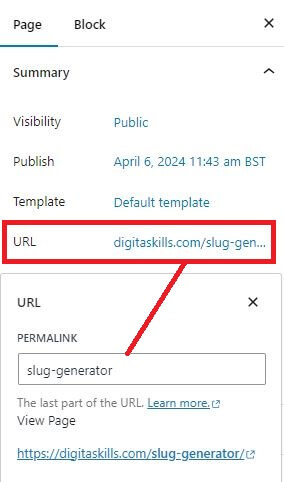In SEO (Search Engine Optimization), a slug refers to the part of a URL that identifies a specific page on a website. It’s the text you see after the domain name and forward slash (/). Here’s a breakdown of its role:
1. Improves User Experience: A good slug is descriptive and tells users what the page is about. This makes it easier for them to understand the content and decide if it’s relevant to their search.
2. Can Help With Rankings (Slightly): While not a major ranking factor, slugs containing relevant keywords can potentially give your page a slight edge in search results. However, Google emphasizes creating slugs for users first, not search engines.
3. Part of the URL Structure: The entire URL, including the slug, helps search engines understand the hierarchy and organization of your website.
Here’s an example:
- Non-SEO friendly slug:
[digitaskills.com]/random-page-123(unclear and lacks keywords) - SEO friendly URL(slug):
[(descriptive, contains relevant keywords)digitaskills.com]/blogs/learn-digital-marketing
What Is The Slug In WordPress
In WordPress, a slug is the editable part of a URL that identifies a specific page or post on your website. Here’s how to change a slug in WordPress for both posts and pages:
1. Locate the Edit Screen:
- For Posts: Navigate to your WordPress dashboard and go to Posts > All Posts. Click on the title of the post you want to edit the slug for.
- For Pages: Go to Pages > All Pages and select the page you want to modify.
2. Access the Permalink Section:
On the edit screen (post or page), look for the Permalink section on the right-hand side below the content editor. This area displays the current URL structure for your content.

3. Edit the Slug:
- You’ll see the editable part of the URL, which is the slug. Click directly on the text next to “URL” (usually it shows the current slug).
- Here you can modify the slug to your desired title.
4. Consider SEO and Readability:
- While editing, keep in mind SEO best practices. Include relevant keywords but prioritize a clear and concise description. Separate words with hyphens for better readability.
5. Save Changes:
- Once you’ve created your new slug, scroll up and click the Publish button (or Update if it’s an existing post/page) to save your changes.
6. Redirects for Old URLs (Optional): If you’re changing the slug of a published post/page, consider using a redirection plugin to automatically redirect visitors from the old URL to the new one. This prevents broken links and ensures a smooth user experience. WordPress plugins like “Redirection”, “Rank Math” or “Yoast SEO” can help with this.
SEO Slug Best Practices
Clarity is King:
- The golden rule: make your slug descriptive. It should tell users what the page is about at a glance. Imagine it as a mini-headline for your content.
- For example, instead of
[yourwebsite.com]/blog/?p=123, use[yourwebsite.com]/blog/best-hiking-trails-californiawhich is clear and informative.
Target Keywords (But Don’t Stuff):
- Including relevant keywords in your slug can be a slight SEO bonus. Prioritize natural language over keyword stuffing.
- A good slug should read naturally while incorporating a target keyword or two.
Keep it Short and Sweet:
- Aim for concise slugs, ideally between 2 to 5 words or under 60 characters. Long, complex slugs can be confusing and hurt readability.
Hyphens for the Win:
- Separate words in your slug with hyphens (
-) for better understanding. This improves readability for both users and search engines. - Avoid underscores (
_) as they’re not always interpreted correctly by search engines.
Think Long-Term:
- While trends may change, choose a slug that reflects the core content of your page. This ensures long-term relevance and avoids the need for frequent changes.
Bonus Tip: Consistency is Key
- Maintain a consistent slug format across your website. This improves organization and helps search engines understand your website structure.
How To Use Slug Generator Online
Our online slug generator is a handy tool that can help you create SEO-friendly and user-friendly slugs for your website content. Here’s a general guide on how to use them:
Input the title, heading, or text you want to convert into a slug in the left text box. This will generate a suggested slug based on your input and show at the right text box.
The generated slug might not always be perfect. You can always edit the suggested slug directly in the text box to make these adjustments.
Once you’re happy with the slug, copy it and paste it into your website’s content management system (CMS) when creating or editing a page or post.
